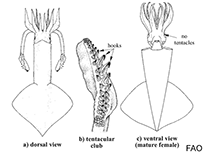Onychoteuthis borealijaponica Okada, 1927
Boreal clubhook squidGoogle image | No image available for this species;
drawing shows typical species in Onychoteuthidae.
Classification / Names Κοινά ονόματα | Συνώνυμα | CoL | ITIS | WoRMS
Cephalopoda | Oegopsida | Onychoteuthidae
Environment: milieu / climate zone / εύρος βάθους / distribution range Οικολογία
Πελαγικό(ά). Tropical; 9°C - 13°C (Αναφ. 275); 57°N - 22°N, 123°E - 111°W (Αναφ. 275)
Distribution Χώρες | Περιοχές FAO | Οικοσυστήματα | Παρουσίες | Εισαγωγές
Pacific Ocean and Northeast Atlantic: from Japan to USA.
Length at first maturity / Μέγεθος / Weight / Age
Γεννητική Ωρίμανση: Lm ? range ? - ? cm Max length : 30.0 cm ML αρσενικό/απροσδιόριστο; (Αναφ. 275); 37 cm ML (female); μεγ. δημοσιευμένο βάρος: 1.10 g (Αναφ. 275)
Life cycle and mating behavior Γεννητική Ωρίμανση | Αναπαραγωγή | Γεννοβολία | Eggs | Γονιμότητα | Larvae
Main reference
Αναφορές | Συντονιστής | Συνεργάτες
Wood, J.B. and C.L. Day 1998 CephBase. http://www.cephbase.utmb.edu/. [Accessed 26/01/06]. (Αναφ. 3722)
IUCN Red List Status
(Αναφ. 130435: Version 2025-1)
CITES status (Αναφ. 108899)
CMS (Αναφ. 116361)
Threat to humans
Human uses
αλιεία: Εμπορικό(ά)
| FishSource |
Εργαλεία
Περισσότερες πληροφορίες
Διαδικτυακές πηγές
BHL | BOLD Systems | CISTI | DiscoverLife | FAO(Publication : search) | Fishipedia | GenBank (genome, nucleotide) | GloBI | Gomexsi | Google Books | Google Scholar | Google | PubMed | Δέντρο Ζωής | Wikipedia (Go, αναζήτηση) | Zoological Record



